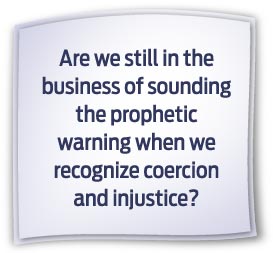
On the evening of November 9, 1938, Nazi-inspired German youths destroyed and vandalized Jewish property, killing and injuring many while police and populace quietly looked the other way. Seventy years later questions linger—questions not only for the German people as a whole, but also for the Seventh-day Adventist Church.
Recently I have been reading a volume edited by Adventist historian Daniel Heinz1 dealing with the question of how the smaller Protestant denominations in Germany (Baptists, Quakers, Mennonites, and many others) handled the racism, nationalism, and sheer evil of the Nazi regime during those dark years between 1933 and 1945.2 The book also contains a chapter on Seventh-day Adventists, carefully chronicling the pressures and realities of this time within our denomination. The story is not pretty, as it documents the stunning silence of Adventist leadership regarding the increasingly clear Nazi design of exterminating German (and other) Jews. To be sure, Adventist leaders of that time recognized the godless nature of race ideology, and there is evidence of those that spoke out valiantly against it. However, after a 10-day ban of the denomination in 1933, the Damocles sword of persecution threatened the German brothers and sisters and moved the leadership to adopt a survival strategy of silence. Most Adventists (both individually and corporately) did not find the courage to speak out publicly against the ruthless and godless ideology and politics of the Nazi regime.3
 Over the past decades German Seventh-day Adventist scholars and leadership have grappled with the role we as a church played so many decades ago,4 leading to the publication of an official recognition of past mistakes and a renewed pledge to never again allow state ideology to override divinely ordained principles of truth and justice.5
Over the past decades German Seventh-day Adventist scholars and leadership have grappled with the role we as a church played so many decades ago,4 leading to the publication of an official recognition of past mistakes and a renewed pledge to never again allow state ideology to override divinely ordained principles of truth and justice.5
What have the actions (or lack thereof) of Adventists in Germany more than 70 years ago to do with an editorial in the flagship magazine of the Seventh-day Adventist Church in 2011? The past 10 years have witnessed great changes on the international scene. The painful war on terror has resulted in an increasing willingness to accept the interference and control of governments in the lives of individuals and communities. This is a global phenomenon. Furthermore, Seventh-day Adventists are now counted in the millions (as compared to a total of roughly 380,000 at the end of 1933), and in many countries they represent a sizable group that is courted by politicians eager to secure votes. Just think of the many Adventists in Brazil, Zimbabwe, Venezuela, Nigeria, Peru, or the Philippines.
Are we still willing to preach the Word in season and out of season? Are we willing to stand with the persecuted and be counted, even though it may mean personal or communal discomfort, limitation, or even persecution? Are we still in the business of sounding the prophetic warning when we recognize coercion and injustice and oppression, or have we become too interested in preserving the status quo?
It is easy enough to look back at the mistakes of our forebears and shake our heads, but are we willing to individually live the statement signed by our church leadership in Germany in 2005?
“We want to advocate that we will be able to ‘distinguish the spirits’ and be ready to confess our faith boldly when we will face our ‘hour of temptation.’ ”
Hopefully, this is not just a well-crafted statement collecting dust in a folder in Germany.
__________
1 Heinz is director of the European Archives of Seventh-day Adventist History located at Friedensau University in Germany.
2 D. Heinz, ed., Freikirchen und Juden im “Dritten Reich”: Instrumentalisierte Heilsgeschichte, antisemitische Vorurteile und verdrängte Schuld, Kirche–Konfession–Religion 54 (Göttingen: Vandenhoeck and Ruprecht, 2011).
3 However, to set the record straight: the chapter also notes a number of individuals that did not remain silent or frozen in fear.
4 See, for example, D. Heinz, “Adventisten und Nationalsozialismus: Trauma einer Generation,” Adventecho-Extra (May 2005), pp. 32-34, or Johannes Hartlapp, Siebenten-Tags Adventisten im Nationalsozialismus, Kirche–Konfession–Religion 53 (Göttingen: Vandenhoeck and Ruprecht, 2008).
5 The statement was signed by the presidents of the two German unions as well as the Austrian union and published in the denomination’s magazine Adventecho, May 2005, p. 31.
______________
Gerald A. Klingbeil is an associate editor of the Adventist Review. This article was published July 28, 2011.